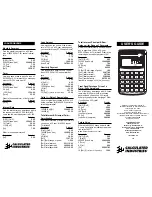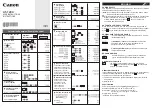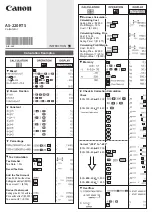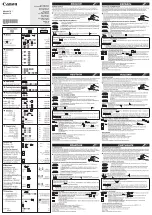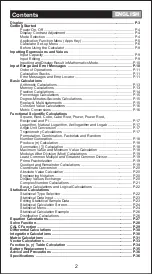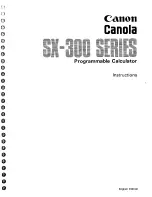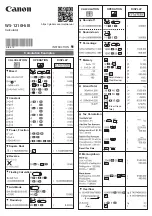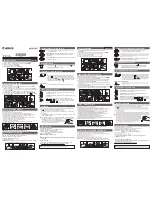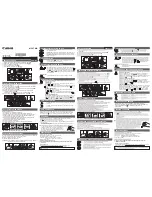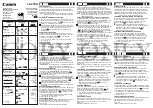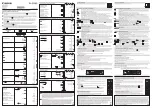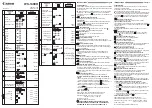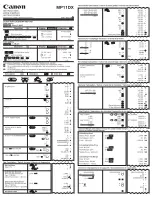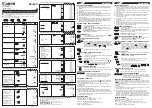
obtained. Therefore it is important that the the proportional band Xp,
the integrating time Ti, and the differentiating time Td are adjusted
according to the present application. Before setting the parameter,
the me thod of regulation direct / inverted must be determined. Direct
controlling results in an increasing output when the process value is >
the setpoint. Inverted controlling results in a decreasing output when
the process value is > the setpoint. Less experienced users may use
the following rule-of-thumb for determining the process parameters:
1. Set Xp at max., Ti and Td at 0 (only proportional controlling).
2. Reduce Xp until the process starts oscillating.
3. Double Xp.
4. Set Ti at max.
5. Reduce Ti until the process starts reoscillating.
6. Double Ti.
7. If the controller is too slow reaching its setpoint, the differential
controller can be activated. The differential function increases the
control signal proportionally to the rise time of the process signal.
Therefore the setting varies according to the process.
012 = Manual / Automatic controller:
The digital input is used to switch between the manual and automatic
mode. A deactivated digital input results in the auto function, where
the value of input A is transferred to the output. An activated digital
input results in the manual function, where the output adopts the value
of input A when activated. Now the output can be activated up or
down manually. The output holds the manual setting for an unlimited
period. The setting is saved at power failure.
013 = Signal limiter:
The output follows the value of the selected analogue input (A or B)
linearly in the range between the min. and max. settings. At input
signals smaller than the min. or greater than the max. settings, the
output is held on the min. or max. value respectively. The min. or max.
value can be set externally via the other analogue input.
014 = Averaging function:
The averaging function reads the input value of the selected A or B
channel every 20 ms and adds up the measurements in a memory.
When the averaging time has expired, the average value is calculated
by dividing the memory value by the number of measurements made,
and the output is then updated by this value. The averaging function
61
When calculating scale factors the input and output signal spans
always have values between 0 and 1. When adding 2 identically scaled
input signals of for instance 4...20 mA, the output would be 8...40 mA
at the same scaling. But as the output follows standard current signals
of 0/4...20 mA, the scaling on the output is double of the scaling on
the inputs. This means that each input must be scaled by only half
the scale of the output. The figures can be calulated according to the
following expression (P1*A + P2*B + P3) = 1, and with this in mind it
will be (0.5*1+0.5*1 + 0) = 1.
When adding 2 differently scaled input signals, the scale factors can
be calculated as follows:
Signal A is 4...20 mA corresponding to a flow of 0...100 m3 / h
Signal B is 4...20 mA corresponding to a flow of 0...150 m3 / h
The output signal of 4...20 mA must correspond to a flow of 0...250 m3 / h
Signal A must be scaled by 100/250 corresponding to a scale factor
P1 of 0.4.
Signal B must be scaled by 150/250 corresponding to a scale factor
P2 of 0.6.
008 = Sample-Hold:
When the digital input is deactivated, the analogue output follows the
selected analogue input (A or B). When the digital input is activated,
the output value is fixed at the value it had when activated until the
digital input is deactivated. The hold value is saved at power failure.
009 = Peak-Hold:
When the digital input is deactivated, the greatest value (the peak
value) of the selected analogue input (A or B) since the latest reset is
held. An activated digital input will reset the peak value to the value
that the input had when activated. By inverting the input and output
signals, the smallest input value is held. The peak value is saved at
power failure.
010 = Time delay:
The output follows the values of the selected input (A or B) averaged
according to an exponential function.
011 = PID controller:
In a correctly tuned PID controller, the constant error will be eliminated.
This means that at a correctly tuned Xp, Ti, and Td, a regulation
accuracy close to what the process value can be measured to can be
60
Summary of Contents for 2289
Page 7: ...BLOCK DIAGRAM 2289B 45 BLOCK DIAGRAM 2289A 44 ...
Page 17: ...65 64 ...
Page 18: ...67 66 ...



















